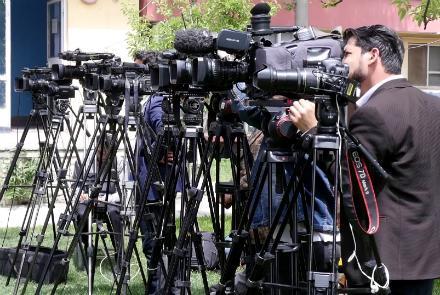Human Rights Watch has accused the Taliban of "deliberately targeting journalists and other media workers, including women," in Afghanistan, saying that such attacks and threats have increased sharply since the start of the talks between the Afghan government and the Taliban in Doha.
The watchdog says these attacks increase concerns about preserving freedom of expression and the media in any peace settlement.
Human Rights Watch (HRW) says it has found that “the Taliban commanders and fighters have engaged in a pattern of threats, intimidation, and violence against members of the media in areas where the Taliban have significant influence, as well as in Kabul.”
Those making the threats often have an intimate knowledge of a journalist’s work, family, and movements and use this information to either compel them to self-censor, leave their work altogether, or face violent consequences, the watchdog says.
Provincial and district-level Taliban commanders and fighters also make oral and written threats against journalists beyond the areas they control, HRW says, adding that according to journalists, the widespread nature of the threats has meant that no media workers feel safe.
“A wave of threats and killings has sent a chilling message to the Afghan media at a precarious moment as Afghans on all sides get set to negotiate free speech protections in a future Afghanistan,” said Patricia Gossman, associate Asia director. “By silencing critics through threats and violence, the Taliban have undermined hopes for preserving an open society in Afghanistan.”
The watchdog says it has interviewed 46 members of the Afghan media between November 2020 and March 2021, seeking information on the conditions under which they work, including threats of physical harm.
Those interviewed included 42 journalists in Badghis, Ghazni, Ghor, Helmand, Kabul, Kandahar, Khost, Wardak, and Zabul provinces and four who had left Afghanistan due to threats, HRW says.
In a number of cases that Human Rights Watch documented, Taliban forces detained journalists for a few hours or overnight.
In several cases they or their colleagues were able to contact senior Taliban officials to intercede with provincial and district-level commanders to secure their release, indicating that local commanders are able to take decisions to target journalists on their own without approval from senior Taliban military or political officials.
Taliban officials at their political office in Doha, Qatar, have denied that their forces threaten the media and say that they require only that journalists respect Islamic values, according to HRW.
But Taliban commanders throughout Afghanistan have threatened journalists specifically for their reporting, the watchdog says, adding that the commanders have considerable autonomy to carry out punishments, including targeted killings.
Women journalists, especially those appearing on television and radio, face particular threats, the watchdog says, mentioning recent wave of attacks.
According to HRW’s findings, a journalist covering the fighting in Helmand province said that one of his sources told him the Taliban were looking for him and he should lie low. “The majority of Afghan journalists feel intimidated and threatened,” he said. “All the journalists are scared because everyone feels like they could be next.”
The watchdog called on the Taliban leadership to “immediately cease intimidation, threats, and attacks against journalists and other media workers.”
“It’s not enough for Taliban officials in Doha to issue blanket denials,” Gossman said.
The watchdog quotes the Journalists Safety Committee as saying that “since the beginning of the spike in targeted killings in early November [2020], supporters of the group [Taliban] have welcomed the killings of journalists on social media, calling these killings in many cases a religious duty.”
Taliban supporters accuse journalists of being agents of Western countries and corrupted by Western values, thereby legitimizing any violence against journalists and the media as not only being permissible but a key part of their war, the HRW says quoting the journalists' safety committee.
Talking about the nature of the threats, the HRW quotes a radio presenter in Zabul province as saying that he and his colleagues routinely receive threats from the Taliban accusing them of giving the government publicity.
In Ghazni province, the HRW says, reporters say that they have been threatened and intimidated by various groups and do not know who is behind every attack.
The Afghanistan Journalists Safety Committee said that in Ghazni province, the Taliban had instructed the majority of the local media outlets that they would only be permitted to continue media activities if they followed Taliban directives.
The watchdog also narrates similar incidents in Kabul and Helmand province.
The Taliban has often denied their involvement in attacks on journalists.


